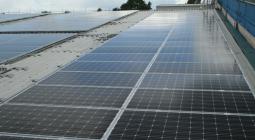Puerto Rico is on its way to 100% renewable electricity.

A bill to mandate that the island’s electric system move to 100% renewable energy by 2050 has passed the Puerto Rico Senate and is being sent to the House for reconciliation, the last stop before it is expected to be signed by Governor Rosselló.
A lot has happened to PS 1121, the 100% renewable energy bill in Puerto Rico, since we saw it last. While the bill has always mandated a move to renewable energy, as of late October solar companies and analysts were issuing warnings that the bill contained language which could make it easier for the island’s utility to impose discriminatory charges on net metering customers.
However, the version of PS 1121 which passed Puerto Rico’s senate last Thursday is very different. According to a LinkedIn post by P.J. Wilson, the president of the Solar + Energy Storage Association of Puerto Rico, the bill not only keeps net metering for the next five years, but shortens interconnection timelines and streamlines permitting for utility-scale solar – an impressive combination of improvements to current processes.
The bill still mandates a move to 100% renewable energy by 2050, and its timeline has been sharply accelerated to require 40% renewable energy by 2025 and 60% by 2040. The bill also exempts energy storage systems from sales tax.
An open process
Javier Rua-Jovet, Sunrun’s director of public policy in Puerto Rico, says that this was the result of a “really open” process, including several public hearings, and a “serious dialogue that clarified things.”
He also points to a “strong consensus” among the various actors, including the executive branch, following Hurricane Maria. “The completely centralized, old-fashioned way to go, was not tenable,” Rua-Jovet told pv magazine.
A consideration of the reliability benefits of distributed solar and storage was part of this. “The fact that power lines failed at all levels is a consideration,” states Rua-Jovet. “Besides that consideration, we had problems in Puerto Rico procuring fossil fuels after the hurricane. You want to have more local resources prioritized.”
This will likely mean changes to the plans of the island’s utility. The Puerto Rico Electric Power Authority (PREPA) had issued a draft plan to break the island’s main grid into “mini-grids” powered largely by solar and storage, but had largely ignored rooftop solar and other forms of behind-the-meter generation. That plan had been sent back by regulators, and now will likely have to include a greater role for distributed generation.
100% goes nationwide
From here the bill will go to Puerto Rico’s House of Representatives, which had already passed the earlier version of the bill last session, for reconciliation. From there it will go to the desk of Governor Rosselló, who is expected to sign it.
When this bill in Puerto Rico and a bill in New Mexico mandating 100% zero-carbon electricity is signed by the governors of the two jurisdictions, there will be five state-level jurisdictions in the United States that will have mandated a move to 100% zero-carbon and/or renewable energy by 2050: Hawaii (100% renewable by 2045), California (100% zero-carbon by 2045), Washington D.C. (100% renewable by 2032), New Mexico (100% zero-carbon by 2045) and Puerto Rico (100% renewable by 2050). The total population of these five areas is 47 million persons, or roughly 14% of the total U.S. population.
Sunnova, the largest non-utility electricity supplier in Puerto Rico, noted these other state-level commitments in a statement on the passage of PS 1121. “Sunnova is thrilled that Puerto Rico is joining HI, CA, DC and NM in their commitment to 100% renewable energy,” stated Meghan Nutting, the executive VP of policy and communications for Sunnova. “Given the abundance of sun on the island, we believe that solar will be able to play a significant role in meeting the 100% goal.”
And this may be only the beginning, as the governors of a number of other U.S. states have also expressed plans to move their states to 100% renewable energy. Also, more than 100 U.S. cities have made commitments to move to 100% renewable energy, including Chicago, which at 2.7 million persons is the largest city in the nation to make such a commitment to date.
18 March 2019
![]()







